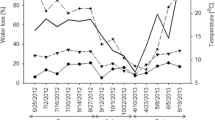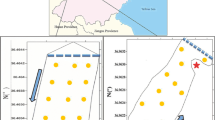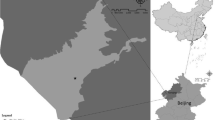Abstract
Slightly polluted water has become one of the main sources of nitrogen contaminants in recent years, for which constructed wetlands (CW) is a typical and efficient treatment. However, the knowledge about contribution of individual nitrogen removal pathways and nitrogen balance in constructed wetlands is still limited. In this study, a stable-isotope-addition experiment was performed in laboratory-scale constructed wetlands treating slightly polluted water to determine quantitative contribution of different pathways and temporal variation of nitrogen balance using Na15NO3 as tracer. Microbial conversion and substrate retention were found to be the dominant pathways in nitrogen removal contributing 24.4–79.9 and 8.9–70.7 %, respectively, while plant contributed only 4.6–11.1 % through direct assimilation but promoted the efficiency of other pathways. In addition, microbial conversion became the major way to remove N whereas nitrogen retained in substrate at first was gradually released to be utilized by microbes and plants over time. The findings indicated that N2 emission representing microbial conversion was not only the major but also permanent nitrogen removal process, thus keeping a high efficiency of microbial conversion is important for stable and efficient nitrogen removal in constructed wetlands.





Similar content being viewed by others
References
Abell GCJ, Revill AT, Smith C, Bissett AP, Volkman JK, Robert SS (2010) Archaeal ammonia oxidizers and nirS-type denitrifiers dominate sediment nitrifying and denitrifying populations in a subtropical macrotidal estuary. ISME J 4:286–300
Bastviken SK, Weisner SEB, Thiere G, Svensson JM, Ehde PM, Tonderski KS (2009) Effects of vegetation and hydraulic load on seasonal nitrate removal in treatment wetlands. Ecol Eng 35:946–952
Chen Y, Wen Y, Zhou Q, Vymazal J (2014) Effects of plant biomass on nitrogen transformation in subsurface-batch constructed wetlands: a stable isotope and mass balance assessment. Water Res 63:158–167
Erler DV, Eyre BD, Davison L (2010) Temporal and spatial variability in the cycling of nitrogen within a constructed wetland: a whole-system stable-isotope-addition experiment. Limnol Oceanogr 55:1172–1187
Faulwetter JL, Gagnon V, Sundberg C, Chazarenc F, Burr MD, Brisson J, Camper AK, Stein OR (2009) Microbial processes influencing performance of treatment wetlands: a review. Ecol Eng 35:987–1004
Feast NA, Dennis PF (1996) A comparison of methods for nitrogen isotope analysis of groundwater. Chem Geol 129:167–171
Garcia-Lledo A, Vilar-Sanz A, Trias R, Hallin S, Baneras L (2011) Genetic potential for N2O emissions from the sediment of a free water surface constructed wetland. Water Res 45:5621–5632
Gu BH, Dreschel T (2008) Effects of plant community and phosphorus loading rate on constructed wetland performance in Florida, USA. Wetlands 28:81–91
Harrison MD, Groffman PM, Mayer PM, Kaushal SS (2012) Nitrate removal in two relict oxbow urban wetlands: a 15N mass-balance approach. Biogeochemistry 111:647–660
Huang XY, Zhang TP, Li WJ, Wan JQ, Dahlgren RA (2013) Spatial variations in the N2O emissions and denitrification potential of riparian buffer strips in a contaminated urban river. Chem Ecol 29:529–539
Huett DO, Morris SG, Smith G, Hunt N (2005) Nitrogen and phosphorus removal from plant nursery runoff in vegetated and unvegetated subsurface flow wetlands. Water Res 39:3259–3272
Kadlec RH, Tanner CC, Hally VM, Gibbs MM (2005) Nitrogen spiraling in subsurface-flow constructed wetlands: implications for treatment response. Ecol Eng 25:365–381
Lee CG, Fletcher TD, Sun GZ (2009) Nitrogen removal in constructed wetland systems. Eng Life Sci 9:11–22
Li KY, Liu ZW, Gu BH (2010) The fate of cyanobacterial blooms in vegetated and unvegetated sediments of a shallow eutrophic lake: a stable isotope tracer study. Water Res 44:1591–1597
Liu DD, Li ZK, Zhang WG (2014) Nitrate removal under different ecological remediation measures in Taihu Lake: a 15N mass-balance approach. Environ Sci Pollut Res 21:14138–14145
Matheson FE, Sukias JP (2010) Nitrate removal processes in a constructed wetland treating drainage from dairy pasture. Ecol Eng 36:1260–1265
Matheson FE, Nguyen ML, Cooper AB, Burt TP, Bull DC (2002) Fate of N-15-nitrate in unplanted, planted and harvested riparian wetland soil microcosms. Ecol Eng 19:249–264
Meda A, Cornel P (2010) Aerated biofilter with seasonally varied operation modes for the production of irrigation water. Water Sci Technol 61:1173–1181
Moffat AS (1998) Global nitrogen overload problem grows critical. Science 279:988–989
Patterson L, Cooper DJ (2007) The use of hydrologic and ecological indicators for the restoration of drainage ditches and water diversions in a mountain fen, cascade range, California. Wetlands 27:290–304
Payne EG, Fletcher TD, Russell DG, Grace MR, Cavagnaro TR, Evrard V, Deletic A, Hatt BE, Cook PL (2014) Temporary storage or permanent removal? The division of nitrogen between biotic assimilation and denitrification in stormwater biofiltration systems. PLoS One 9:890–898
Philippot L, Andert J, Jones CM, Bru D, Hallin S (2011) Importance of denitrifiers lacking the genes encoding the nitrous oxide reductase for N2O emissions from soil. Glob Chang Biol 17:1497–1504
Reinhardt M, Muller B, Gachter R, Wehrli B (2006) Nitrogen removal in a small constructed wetland: an isotope mass balance approach. Environ Sci Technol 40:3313–3319
Saeed T, Sun G (2013) A lab-scale study of constructed wetlands with sugarcane bagasse and sand media for the treatment of textile wastewater. Bioresour Technol 128:438–447
Smith VH (2003) Eutrophication of freshwater and coastal marine ecosystems—a global problem. Environ Sci Pollut Res 10:126–139
Smith VH, Tilman GD, Nekola JC (1999) Eutrophication: impacts of excess nutrient inputs on freshwater, marine, and terrestrial ecosystems. Environ Pollut 100:179–196
Tanner CC, Nguyen ML, Sukias JPS (2005) Nutrient removal by a constructed wetland treating subsurface drainage from grazed dairy pasture. Agric Ecosyst Environ 105:145–162
Wozniak JR, Childers DL, Anderson WT, Rudnick DT, Madden CJ (2008) An in situ mesocosm method for quantifying nitrogen cycling rates in oligotrophic wetlands using 15N tracer techniques. Wetlands 28:502–512
Wu H, Zhang J, Wei R, Liang S, Li C, Xie H (2013) Nitrogen transformations and balance in constructed wetlands for slightly polluted river water treatment using different macrophytes. Environ Sci Pollut Res 20:443–451
Yang X, Zhang X, Wang J, Zhao G, Wang B (2014) Performance of the subsurface flow constructed wetlands for pretreatment of slightly polluted source water. Ecotoxicology 23:699–706
Zhang JB, Cai Z, Cheng Y, Zhu T (2009) Denitrification and total nitrogen gas production from forest soils of Eastern China. Soil Biol Biochem 41:2551–2557
Zhang JB, Zhu TB, Cai ZC, Qin SW, Muller C (2012) Effects of long-term repeated mineral and organic fertilizer applications on soil nitrogen transformations. Eur J Soil Sci 63:75–85
Zhou S, Sugawara S, Riya S, Sagehashi M, Toyota K, Terada A, Hosomi M (2011) Effect of infiltration rate on nitrogen dynamics in paddy soil after high-load nitrogen application containing 15N tracer. Ecol Eng 37:685–692
Acknowledgments
We would like to sincerely thank Prof. Jinbo Zhang and his team for providing valuable advices and help on 15N abundance analysis. This study was financially supported by research projects of the Major State Water Pollution Control and Treatment Technique Programs of China (No. 2012ZX07101006 and No. 2013ZX07101014-001).
Author information
Authors and Affiliations
Corresponding author
Ethics declarations
Compliance with ethical standards
We confirm that all the data are original and this manuscript has not been published elsewhere and is not under consideration for publication anywhere else. All authors have read the manuscript and accept responsibility for this manuscript. Its publication has been approved by all authors.
We understand that the corresponding author is the sole contact for the editorial process (including editorial manager and direct communications with the office). He is responsible for communicating with the other authors about progress, submissions of revisions, and final approval of proofs. We confirm that we have provided a current, correct email address which is accessible by the corresponding author and which has been configured to accept an email from zhkuili@nju.edu.cn.
Conflict of interest
The authors declare that they have no competing interests.
Additional information
Responsible editor: Hailong Wang
Rights and permissions
About this article
Cite this article
Zhang, W., Lei, Q., Li, Z. et al. Temporal variation of nitrogen balance within constructed wetlands treating slightly polluted water using a stable nitrogen isotope experiment. Environ Sci Pollut Res 23, 2677–2683 (2016). https://doi.org/10.1007/s11356-015-5485-4
Received:
Accepted:
Published:
Issue Date:
DOI: https://doi.org/10.1007/s11356-015-5485-4




